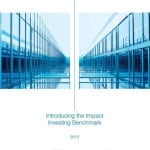Cambridge Associates and the Global Impact Investing Network (GIIN) announced the release of the Impact Investing Benchmark. The new report provides comprehensive analysis of the financial performance of market rate private equity and venture capital impact investing funds.
Highlights include:
- Impact investment funds that raised under $100 million returned a net IRR of 9.5% to investors, outperforming similar-sized funds in the comparative universe (4.5%), impact investment funds over $100 million (6.2%), and funds over $100 million in the comparative universe (8.3%).
- Emerging markets impact investment funds have returned 9.1% to investors versus 4.8% for developed markets impact investment funds. Those focused on Africa have performed particularly well, returning 9.7%.
 Cambridge Associates and GIIN created the benchmark to address the lack of robust research on financial performance of funds with an impact investing strategy. They expect the benchmark to help spur growth in the early stage impact investment industry by helping investors better identify strategies that fit their impact criteria.
Cambridge Associates and GIIN created the benchmark to address the lack of robust research on financial performance of funds with an impact investing strategy. They expect the benchmark to help spur growth in the early stage impact investment industry by helping investors better identify strategies that fit their impact criteria.
At launch, the Impact Investing Benchmark includes 51 private investment funds. The funds selected pursue a range of social impact objectives, operate across geographies and sectors, and were launched in 1998 to 2010. (AGC was launched after the inclusion dates.)







